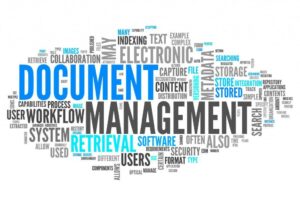Many of Unbaised Consulting’s prospects and clients are routinely confused by the nomenclature and differences between Contract Management, Contract Discovery and Document Management Systems opportunities and solutions. What follows is intended to offer some clarity between contract and document terminology and scope of technologies.
Contract Lifecycle Management (CLM) Systems
Contract lifecycle management systems are specifically designed to do just that – manage contracts throughout their lifecycle. They are targeted solely to that function and manage contracts throughout the organization. A big benefit of dedicated CLM systems is there use as a centralized, authoritative repository/database of contracts, amendments, and renewals.

Most CLM systems include functionality designed to manage each of these contracting stages:
- Request/Initiation: Those with access to the CLM system, whether from the law department, the procurement department, or business units, can initiate a contract request.
- Drafting: CLM systems facilitate the drafting of contracts using libraries of customized templates and clauses, typically pre-approved by the law department.
- Negotiation: CLM systems track negotiations, including draft agreements, for reference and audit purposes. The system can track changes and versions of a contract and can flag exceptions to standard terms. CLM systems can also automate the approval process using pre-established criteria, sending notifications to the appropriate parties.
- Execution: CLM systems document and track contract execution.
- Obligations management: Many provide post-execution monitoring tools to proactively track the performance of obligations and provide notifications when terms are met or on key dates. They can monitor legal covenants and requirements.
CLM systems can be integrated with other systems such as customer relationship management (CRM) systems and enterprise resource planning (ERP) systems. For these reasons, most CLM systems are considered functionally rich, “enterprise-grade” solutions, that can be used by teams both inside and outside the Legal function—e.g., Procurement and Sales.
Contract Discovery and Analytics (CDA) Systems
Most organizations want to leverage their contract terms and conditions to maximize value and minimize the potential for non-compliance with laws and regulations. Contract discovery and analytics (CDA) systems use latest-generation artificial intelligence (AI) processing to automate procedures in identification of opportunities for revenue recovery and risk avoidance. These solutions can support the systematic review of a large contract dataset to assess and ensure compliance with corporate standard terms and conditions. This application of a machine-learning platform can greatly reduce the time (duration and man hours) and accuracy of collection, extraction, testing, and review associated with what has historically proven to be a highly labor-intensive process.
CDA systems include functionality designed to manage the extraction and review stage of contract analysis:
- Extraction and Review – CDA systems are designed to extract relevant policies and provisions that represent potential opportunities for revenue recovery and/or risk mitigation and cull these agreements into a contract subset for further strategy and execution.
Additional benefits in ongoing use of a contract discovery and analytics system include:
- Aid in contract classification and metadata extraction in preparation for intake into a contract lifecycle management (CLM) system;
- Assistance in identification of areas of regulatory and internal policy non-compliance and opportunities for additional revenue recognition;
- Access to a true web-based SaaS solution that can be accessed from anywhere (as opposed to having to invest in purchase of software and its installation and use on premises).
CDA systems functionally complement the use of CLM systems to properly monitor and control contracts. As a result, many organizations subscribe to both CLM and CDA solutions as a means of managing the contract lifecycle while leveraging its value.
Document Management Systems (DMS)
Not every organization needs all the functionality of a full-blown contract management system. Document management systems streamline document creation, leverage existing work product, facilitate document collaboration, and provide a central repository for document storage. They can thus be used to manage some stages of contract management within the law department; in particular, drafting (including tracking revision history) and storage. They do not, however, include functions for tracking negotiation and execution of agreements, nor do they automate contract management such as post-execution obligations management, renewals, or compliance (although they may provide the information needed to perform those tasks).

A DMS typically manages each of the following document stages:
- Create/Capture: A DMS facilitates the creation and storage of documents in multiple formats (Microsoft Office, Adobe, etc.). They allow for the re-use of existing knowledge since they can include “best of breed” documents, templates, or other helpful information, and thus can be useful in contract drafting.
- Manage/Version Control: A DMS includes mechanisms for controlling versions of documents and also control access and security, tracking physical files or allowing check-in and check-out of electronic files. Because they log transactions, they provide an audit trail of versions. Document management systems use metadata from documents to create document profiles including information such as document type, date, author, and more – information that can later be used for managing obligations and compliance.
- Deliver: A DMS provides a collaborative workspace for publishing and team review, which can be used to facilitate the approvals process. They provide full-text indexing and offer offline, remote access.
- Retain/Archive: A DMS offers a central storage repository; they can also be integrated with enterprise applications such as corporate record management systems.
Summary
CLM systems are specifically targeted for the management of an organization’s contracts. They facilitate each phase of the contract lifecycle, automating much of the process. Document management systems are not ideal for enterprise-wide contract management but can be useful for some aspects of contract management within the law department, where they can serve multiple functions. They can be integrated with matter management systems and knowledge management systems, facilitating the drafting of a variety of law department documents in a collaborative environment. Because of this broad functionality, DMS solutions do not offer the functions specifically tailored to contracts that can be found in CLM systems, such as automated approvals or obligations management and the related automated notices. They can, however, be tailored to assist with some contract management functions within the law department. Specifically, they can facilitate contracts drafting using templates and prior examples, track revisions, provide a central, collaborative space facilitating approvals, and collect profile information that can be used for subsequent contract management.
Many organizations subscribe to both document and contract management systems and use them for different purposes and in achievement of different results.

